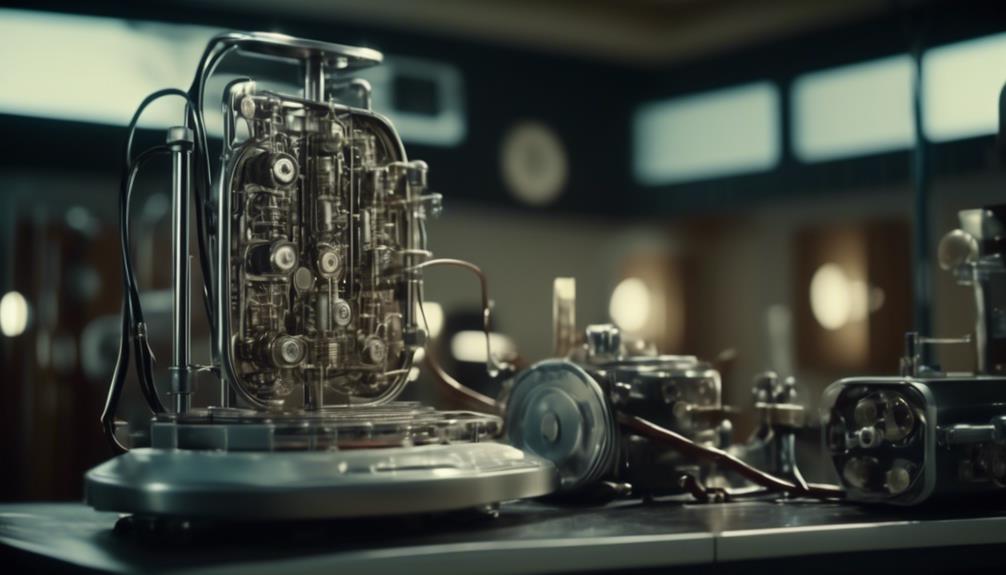First Kidney Dialysis Machine (1943) – Kolff: Recap and Summary: Invented the First Practical Artificial Kidney

Dr. Willem Kolff revolutionized nephrology in 1943 with his invention of the first practical artificial kidney. This invention paved the way for countless lives to be saved and future advancements in artificial kidney technology.
Key Takeaways
- Dr. Kolff was driven by empathy for patients and a relentless pursuit of innovation, motivated to find a solution that could save lives and improve healthcare.
- Despite facing skepticism and limited resources, Dr. Kolff overcame challenges through determination and dedication to improving patient lives.
- The first kidney dialysis machine successfully used on a patient marked a significant milestone in medical history, extending the lives of countless patients and laying the foundation for advancements in renal medicine.
- Dr. Kolff's invention paved the way for ongoing advancements in dialysis technology and the treatment of kidney disease, revolutionizing the field of nephrology and improving patient outcomes worldwide.
Early Life and Education
During his early life and education, Willem Johan Kolff laid the foundation for his groundbreaking contributions to medical science. Born on February 14, 1911, in Leiden, Netherlands, Kolff grew up in a family of physicians. This environment fostered his passion for medicine and set him on the path to becoming an innovative inventor.
Kolff's education was characterized by his relentless pursuit of knowledge. He attended the Leiden University Medical Center, where he studied medicine and received his medical degree in 1938. It was during his time at Leiden that Kolff developed a strong interest in renal physiology, which would later shape his pioneering work in kidney dialysis.
While working as a physician in a small hospital in Kampen, Netherlands, Kolff witnessed the tragic deaths of several patients due to kidney failure. This experience ignited his determination to find a solution. Drawing inspiration from his knowledge of engineering, Kolff began experimenting with artificial kidneys.
Kolff's early life and education provided him with a solid foundation in medicine and a deep understanding of renal physiology. These formative years shaped his passion for finding innovative solutions to medical challenges, ultimately leading to the invention of the first practical kidney dialysis machine. Kolff's pioneering work revolutionized the field of medical science and saved countless lives.
The Inspiration Behind the Invention
What led Willem Johan Kolff to invent the first kidney dialysis machine?
The inspiration behind Kolff's invention can be traced back to his experiences as a young doctor during World War II. Kolff witnessed the suffering of patients with kidney failure, who had no treatment options available to them. This motivated him to find a solution that could save lives and improve the quality of healthcare.
Kolff's relentless pursuit of innovation and his deep empathy for patients drove him to experiment with various materials and techniques to develop the first practical artificial kidney.
The impact of Kolff's invention on healthcare can't be overstated. The kidney dialysis machine revolutionized the treatment of kidney failure, providing a lifeline for patients who previously had no hope. It allowed for the removal of waste and excess fluids from the body, mimicking the natural function of the kidneys. This breakthrough invention not only prolonged the lives of countless individuals but also improved their overall well-being and quality of life.
The invention of the kidney dialysis machine paved the way for further advancements in renal care and transplantation. It laid the foundation for the development of more sophisticated dialysis techniques and machines, making the treatment more efficient and accessible. Today, dialysis is a standard procedure in hospitals worldwide, saving the lives of millions of people suffering from kidney failure.
Development Process and Challenges
Kolff's relentless pursuit of innovation and his deep empathy for patients led him to face numerous challenges during the development process of the first kidney dialysis machine. These challenges included:
- Limited resources: In the early 1940s, technological advancements weren't as readily available as they're today. Kolff had to work with limited resources and improvised materials to build the machine. He used sausage casings, cans, and other household items to create the dialyzer.
- Lack of support: Despite his groundbreaking ideas, Kolff faced skepticism from the medical community. Many believed that his invention was too ambitious and wouldn't work. This lack of support made it difficult for Kolff to secure funding and gather a team to assist him in his work.
- Ethical considerations: Developing a machine that could artificially replace kidney function raised ethical questions. Kolff had to navigate these concerns and ensure that his invention was safe and effective for patients. This required extensive testing and research.
- Patient selection: Initially, there were limited patients who could benefit from the dialysis machine. The technology was primarily used for patients with acute kidney injury, and it took time to expand its application to chronic kidney disease.
Despite these challenges, Kolff's determination and dedication to improving the lives of patients drove him to overcome these obstacles. His work laid the foundation for further advancements in dialysis technology and revolutionized the field of nephrology.
Breakthrough: Successful Use on a Patient
After overcoming numerous challenges, the breakthrough moment arrived when the first kidney dialysis machine was successfully used on a patient. This marked a significant milestone in medical history, as it demonstrated the potential for artificial kidneys to provide successful patient outcomes and pave the way for future medical breakthroughs.
The successful use of the kidney dialysis machine on a patient opened up a whole new realm of possibilities in the treatment of kidney disease. Prior to this breakthrough, patients suffering from kidney failure had limited options and faced a bleak prognosis. But with the introduction of the dialysis machine, doctors were able to filter waste products and excess fluids from the bloodstream, effectively mimicking the functions of a healthy kidney.
This groundbreaking achievement not only extended the lives of countless patients but also laid the foundation for further advancements in renal medicine. With the successful patient outcomes observed, researchers and medical professionals were inspired to improve and refine the dialysis machine, leading to more efficient and effective models over time.
The successful use of the first kidney dialysis machine on a patient marked a turning point in medical history. It showcased the remarkable potential of artificial kidneys to save lives and provided hope for patients suffering from kidney failure. This breakthrough set the stage for ongoing advancements in dialysis technology and paved the way for future medical breakthroughs in the treatment of kidney disease.
Impact on the Field of Nephrology
The successful use of the first kidney dialysis machine on a patient not only revolutionized the treatment of kidney disease but also had a profound impact on the field of nephrology. Here are four key ways in which the invention of the kidney dialysis machine has advanced treatment and improved patient outcomes:
- Enhanced Survival Rates:
Prior to the development of the kidney dialysis machine, patients with kidney failure faced almost certain death. The ability to artificially filter waste products and excess fluid from the blood allowed for the prolongation of life in those suffering from renal failure.
- Increased Accessibility:
The invention of the kidney dialysis machine made it possible to provide life-saving treatment to a larger number of patients. Instead of relying solely on kidney transplants, which were limited by the availability of donor organs, dialysis machines allowed for ongoing treatment and management of kidney disease.
- Improved Quality of Life:
Kidney dialysis provides a means for patients to lead more normal lives. By removing waste products and excess fluid from the bloodstream, dialysis helps to alleviate symptoms such as fatigue, nausea, and shortness of breath, thereby improving the overall well-being of patients.
- Advancements in Research:
The development and use of kidney dialysis machines have stimulated research in the field of nephrology. This has led to further advancements in understanding kidney function, the causes of kidney disease, and the development of new treatments and therapies.
Evolution of Dialysis Machines
As you explore the evolution of dialysis machines, you'll discover a rich history of advancements in the field.
From the first crude dialysis machines developed in the 1940s to the sophisticated and efficient models of today, the technology has come a long way.
Innovations in dialysis technology have paved the way for improved patient outcomes, increased efficiency, and enhanced quality of life for those with kidney disease.
Historical Advancements in Dialysis
Significant advancements have propelled the evolution of dialysis machines, revolutionizing the treatment of kidney disease. Here are four historical advancements that have had a profound impact:
- Introduction of Hemodialysis:
In the 1960s, the development of hemodialysis machines allowed for the removal of waste products and excess fluid from the blood, mimicking the function of healthy kidneys.
- Portable Dialysis Machines:
Innovations in the 1980s led to the creation of portable dialysis machines, giving patients the freedom to receive treatment at home or on the go, instead of being confined to a hospital.
- High Flux Dialyzers:
In the 1990s, high flux dialyzers were introduced, improving the efficiency of dialysis by increasing the removal of toxins and enhancing patient outcomes.
- Online Hemodiafiltration:
More recently, online hemodiafiltration has emerged as a promising technique. It combines hemodialysis with additional filtration methods, resulting in better clearance of waste products and potentially reducing the risk of complications.
These advancements in dialysis technology have revolutionized the treatment of kidney disease, providing patients with greater freedom and improved outcomes.
Innovations in Dialysis Technology
After exploring the historical advancements in dialysis, it is now time to examine the evolution of dialysis machines and the innovations that have shaped the field of kidney disease treatment. Over the years, there have been significant advancements in dialysis technology, resulting in more efficient and effective treatment options for patients. These advancements have led to the development of various types of dialysis machines, each with its unique features and applications.
| Type of Dialysis Machine | Advancements |
|---|---|
| Hemodialysis Machine | Introduction of computerized control systems, improved filtration capabilities |
| Peritoneal Dialysis Machine | Development of automated systems for ease of use, enhanced fluid removal |
| Continuous Renal Replacement Therapy (CRRT) Machine | Integration of advanced monitoring systems, precise fluid balancing |
These advancements in dialysis technology have revolutionized the treatment of kidney disease, allowing for better patient outcomes and improved quality of life. The continuous innovation in dialysis machines continues to push the boundaries of what is possible in kidney disease treatment, providing hope for a future where dialysis is even more effective and accessible.
Recognition and Legacy of Dr. Willem Kolff
Dr. Willem Kolff's recognition and legacy in the field of kidney dialysis are widely acknowledged for his groundbreaking invention of the first kidney dialysis machine.
Here are four key reasons why Kolff's contributions are significant:
- Pioneering Invention: Dr. Kolff's invention of the first practical artificial kidney revolutionized the treatment of kidney failure. The dialysis machine he developed allowed patients to filter waste and excess fluid from their blood, providing a lifeline for those suffering from kidney disease.
- Saving Lives: Kolff's invention paved the way for the widespread use of kidney dialysis, which has since saved countless lives. By creating a method to artificially perform the vital functions of the kidneys, he offered hope to patients who previously had no treatment options.
- Continuous Innovation: Dr. Kolff's dedication to improving dialysis technology continued throughout his career. He made significant advancements in dialyzer design, improving efficiency and patient comfort. His commitment to innovation laid the foundation for further developments in the field.
- Global Impact: Kolff's work had a global impact, with his dialysis machine being adopted worldwide. His invention led to the establishment of dialysis centers and the development of kidney transplant programs, ultimately transforming the field of nephrology.
Dr. Willem Kolff's recognition and legacy in the field of kidney dialysis are a testament to his invaluable contributions and the lasting impact of his pioneering work.
Future Prospects: Advancements in Artificial Kidney Technology
Following the groundbreaking invention of the first practical artificial kidney by Dr. Willem Kolff, the field of kidney dialysis has witnessed significant advancements in artificial kidney technology, paving the way for future prospects in this field.
The future of artificial kidney technology holds immense potential benefits for patients suffering from kidney failure.
One of the key areas of future advancement in artificial kidney technology is the development of wearable and portable devices. Currently, traditional dialysis machines require patients to visit a clinic multiple times a week for treatment. However, researchers are working on creating smaller and more portable devices that will allow patients to receive dialysis treatment at home or on the go. This would greatly enhance the quality of life for patients, providing them with more freedom and flexibility.
Another area of future advancement is the improvement of the filtration process in artificial kidneys. Current artificial kidneys still struggle to fully replicate the filtration capabilities of natural kidneys. Researchers are exploring innovative techniques, such as nanotechnology and bioengineering, to develop more efficient filters that can better mimic the functions of natural kidneys. This could lead to more effective removal of waste products and toxins from the blood, resulting in improved patient outcomes.
In addition, the integration of artificial intelligence (AI) and machine learning into artificial kidney technology shows great promise. AI algorithms can analyze large amounts of patient data and make real-time adjustments to the dialysis process, optimizing treatment for each individual patient. This personalized approach has the potential to significantly improve treatment outcomes and reduce complications.
Frequently Asked Questions
What Were the Specific Challenges Faced by Dr. Willem Kolff During the Development Process of the First Kidney Dialysis Machine?
During the development process of the first kidney dialysis machine, Dr. Willem Kolff faced various challenges. These challenges had a significant impact on nephrology, revolutionizing the treatment of kidney disease.
How Did the Successful Use of the First Kidney Dialysis Machine on a Patient Impact the Field of Nephrology?
The successful use of the first kidney dialysis machine had a profound impact on the field of nephrology. It paved the way for significant medical advancements and future innovations in the treatment of kidney diseases.
Can You Provide Some Examples of the Evolution of Dialysis Machines Since the Invention of the First Practical Artificial Kidney?
Since the invention of the first practical artificial kidney, dialysis machines have evolved significantly. Advancements in artificial kidney technology have led to improved efficiency, portability, and patient comfort, revolutionizing the field of nephrology.
What Recognition and Legacy Did Dr. Willem Kolff Receive for His Invention of the First Kidney Dialysis Machine?
Dr. Willem Kolff received recognition and left behind a remarkable legacy for his invention of the first kidney dialysis machine. His groundbreaking innovation revolutionized the treatment of kidney failure and saved countless lives.
What Advancements in Artificial Kidney Technology Are Expected in the Future?
In the future, advancements in artificial kidney technology are expected to revolutionize kidney dialysis. New developments will enhance efficiency, improve patient outcomes, and expand access to life-saving treatment. Exciting progress lies ahead.









